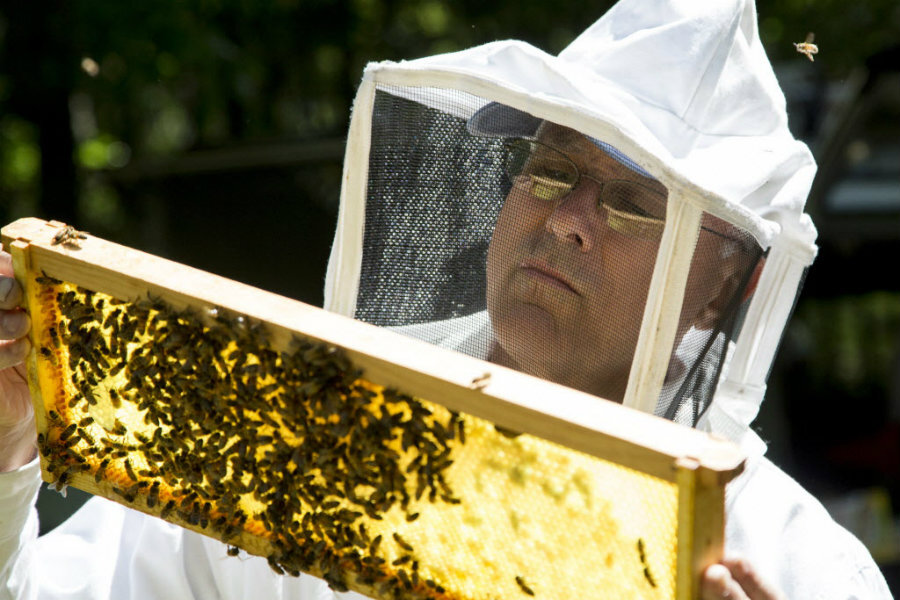Los Angeles buzzing over backyard beehives
Loading...
Los Angeles moved closer this week to allowing residents to keep beehives, making the city the latest front in an urban effort to reinforce bee populations that are vital to agricultural production across the United States.
The Los Angeles City Council approved on Wednesday a draft proposal to allow hobbyist beekeepers to maintain hives in their backyards. The practice hasn’t been allowed in residential zones in Los Angeles, but an increasing number of residents have been doing it anyway, driven by concern about recently dwindling honeybee populations.
L.A. Councilman Jose Huizar says he and his staff have been working on the ordinance with bee experts for a year, in part to ensure that the practice is regulated properly.
“We want to enable this increasingly popular activity even while we preserve the rights of the city to address any complaints about poorly maintained hives,” said Mr. Huizar, according to the Los Angeles Times.
Scientists and farmers have warned that shrinking bee populations – along with California’s ongoing severe drought – could threaten agriculture across the state, the Times reported.
Other US metropolises have also taken up concerns about the bees and have launched efforts to help.
“L.A. is doing what many cities – some decades ago – did,” says Jerry Bromenshenk, a bee expert at the University of Montana in Missoula. “Lots of cities are wrestling with this issue.”
From April 2012 to April 2013, beekeepers reported losing almost 50 percent of honeybee colonies, according to an annual survey conducted by researchers at the Honey Bee Lab at the University of Maryland.
The causes for the decline have remained mysterious and could be the combination of several factors, such as new parasites.
In May of this year, a federal interagency task force released a new plan to stem the loss of bee colonies by creating 7 million acres of bee habitat in the next five years.
“Honey bee pollination alone adds more than $15 billion in value to agricultural crops each year,” John Holdren, director of the White House Office of Science and Technology Policy, said in a blog post accompanying the release of the plan. Pollinators like honeybees are “critical to the nation’s economy,” he wrote.
The panic over bee populations appears to have helped increase public interest in beekeeping.
Rick Molenda, president of Western Bee, a beekeeping supply company in Polson, Mont., says that in the past five years alone, the company’s sales to hobbyist beekeepers have more than doubled.
“I’ve seen it throughout the US,” he says. “Everyone wants to save the bees.”
Sales hit a low around 2006, he adds, when large-scale honeybee die-offs were first reported. But business has been picking up ever since.
“I think the media’s done a good job of making the general population aware of just how important bees are to us,” he says.
And bee colonies, in fact, have been recovering. Last July, the US Department of Agriculture reported that US honeybee colonies hit a 20-year high.
Under the draft proposal in Los Angeles, beekeeping would be allowed in single-family backyards within a buffer zone. Beekeepers would be required to maintain a water source and to raise walls or hedges so bees do not cross paths with neighbors or venture to other properties to get hydrated.
Still, some are worried about the potential dangers of keeping hives in residential areas. Other cities – including nearby Santa Monica – require that applicants hold a city permit or complete an apiary course before being allowed to keep a hive.
Some jurisdictions mandate a minimum distance between hives and schools, and allow neighborhoods to opt out of beekeeping entirely. Those rules are not part of the proposal in Los Angeles, according to the Times.
Dr. Bromenshenk of the University of Montana says that good regulations are necessary to distinguish bee “keepers” from what he calls “bee havers.” The latter, he says, “don’t know anything about bees but take [them], throw them in a [hive], and let nature take its course.”
When bees are left unattended, they can interbreed with Africanized bees – commonly referred to as "killer bees" – and become more aggressive. Diseased bees have also been cited as a concern.
“If you just let those colonies sit in your backyard, they’re going to become a nuisance,” Bromenshenk adds.
Some cities have focused on other potential challenges. In New York, which legalized beekeeping in 2010, some beekeepers have worried that bees might run out of food, leading to weaker bees when more hives are being kept.
“It takes one million flowers to produce enough nectar for one pound of honey,” said Andrew Cote, founder of the New York City Beekeepers Association, in a July 2013 interview with Live Science. “We have the same amount of flowers and trees, but more bees.”
Denver legalized beekeeping in 2008, but regulations can differ from neighborhood to neighborhood, according to David Baker, owner of To Bee or Not to Bee, a store in Littleton, Colo., that sells beekeeping equipment and teaches classes.
Beekeeping is legal in downtown Denver and has been successful, he adds – to the point where the Brown Palace Hotel, one of the city’s most luxurious buildings, has installed beehives on the roof.
There has been a ripple effect from the neighborhoods embracing beekeeping, according to Mr. Baker.
“It’s been so successful in the [neighborhoods] that have adopted it that those that previously had reservations about beekeeping are starting to see that a lot of the problems that people foresee and imagine aren’t really coming to light,” he says.








